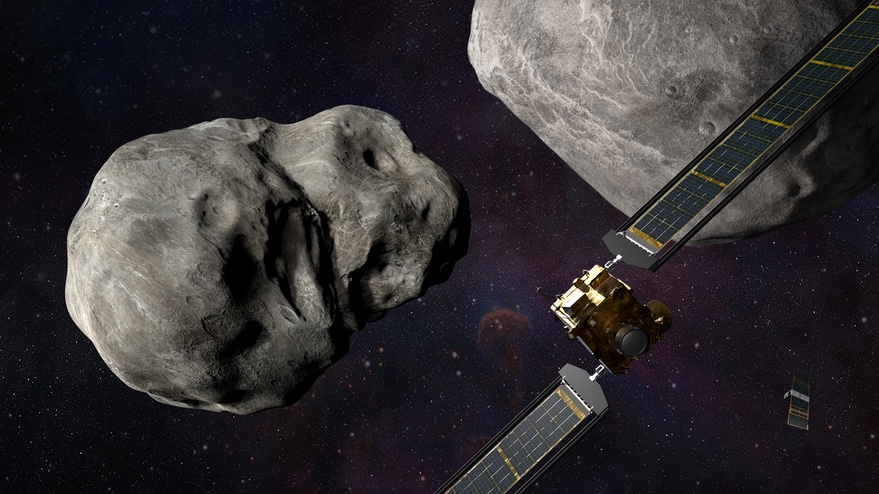WASHINGTON — A NASA spacecraft is on course to deliberately collide with a small asteroid Sept. 26 to test how that technique could be used to deflect a potentially hazardous asteroid.
The Double Asteroid Redirection Test (DART) spacecraft, launched last November, is on a trajectory to collide with Dimorphos, a small asteroid orbiting the larger near Earth asteroid Didymos, at 7:14 p.m. Eastern Sept. 26. The collision will change slightly the orbit of Dimorphos, allowing scientists to measure how effective such a collision, or “kinetic impact,” could be to change the trajectory of any future asteroids that pose a hazard to the Earth.
At a Sept. 22 briefing, project officials said the spacecraft was operating well as it approached the asteroids. “The team is ready, the ground systems are ready and the spacecraft is healthy and on track for an impact on Monday,” said Edward Reynolds, DART project manager at the Johns Hopkins University Applied Physics Lab, which operates the mission.
Targeting Dimorphos, an object about 160 meters across, will be a challenge. The object won’t be resolved by DART’s camera, DRACO, until about an hour before impact. The spacecraft will use software called SMART Nav to lock on to Dimorphos and adjust its trajectory to stay centered on it.
That work will be done autonomously by the spacecraft, although controllers will have the ability to send commands until the final minutes if needed. “We have 21 contingencies that we planned for and are ready to execute,” said Elena Adams, DART mission systems engineer at APL. Those contingencies include adjusting camera settings if Dimorphos is too dim and telling the spacecraft to change objects it is targeting.
Another factor is that scientists don’t know the shape of Dimorphos, which could range from something roughly spherical to highly elongated. “There are a lot of different possibilities of what it could be, and it won’t really be until those last seconds and minutes, as we’re honing in, that we’re going to get a real sense of what it’s made out of, what is its shape,” said Betsy Congdon, DART mechanical lead engineer at APL, in a talk at the International Astronautical Congress in Paris Sept. 22.
The mission is also prepared if DART misses Dimorphos. “If there is a miss, the first thing we have to do is figure out what happened,” said Lindley Johnson, NASA planetary defense officer. “That will be the first thing: to safe the spacecraft, get all the information down from the spacecraft.”
Adams said the 21 contingencies the mission has prepared for includes missing Dimorphos. “We’re going to start preserving all the data on board about why we missed,” she said. “Then we’ll start preserving propellant and we’ll start looking for an object to come back to.”
However, NASA is confident that DART will hit Dimorphos. “Through all the testing that we’ve done,” Johnson said, “I’m highly confident that we’re going to hit on Monday and that it will be a complete success.”
While the impact marks the end of DART the spacecraft, it is only the beginning of the next phase of the overall DART mission. A network of ground-based telescopes will observe the asteroids in the days and weeks after the impact to measure the change in period in the orbit of Dimorphos around Didymos. The Hubble Space Telescope, James Webb Space Telescope and Lucy spacecraft, approaching Earth for a gravity-assist flyby, will also observe the asteroids.
“Different parts of the investigation team have their own ideas about that and they’re competing with each other,” Tom Statler, DART program scientist at NASA, said of the time it would take to determine the new orbit of Dimorphos. “I would be surprised if we had a firm measurement of the period change in less than a few days, and I would be really surprised if it took more than three weeks.”
There may also be images of the impact and aftermath taken by an Italian cubesat called LICIACube that hitched a ride with DART and was deployed earlier this month. LICIACube will pass about 55 kilometers from Dimorphos about three minutes after the impact, collecting images to return to Earth afterwards.
Statler said the rate the cubesat can return images will depend on the spacecraft’s status after the close approach and availability of time on the Deep Space Network. The cubesat, operated by the Italian space agency ASI, will attempt to first return images taken at times most likely to confirm an impact. “I don’t think we should be expecting more than a couple of images per day, on average,” he said.
A successful impact will give NASA more insight into the effectiveness of the kinetic impactor approach to changing the orbit of potentially hazardous asteroids, although agency officials emphasized that Didymos, nor any other known asteroid, poses a near-term impact threat to the Earth. “This demonstration is extremely important to our future here on the Earth, and life on Earth,” said Johnson.
There will be some tension in the control room in the final minutes. “In the last couple of minutes, we’re all going to be standing up, waiting to see us hit an asteroid,” said Adams. The DRACO camera will be returning images at a rate of one per second, with the last taken about 2.5 seconds before impact because of onboard processing, she said. At that point contact with DART will be lost.
“The mood right now is one of nervous excitement,” said Congdon, discussing dress rehearsals for the impact in mission control. “Everyone is confident and really excited about the next couple of days. During this mission dress rehearsal we even practiced cheering for the loss of signal.”
